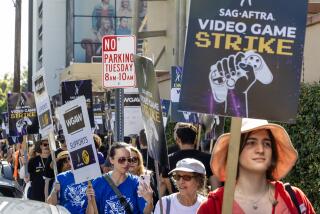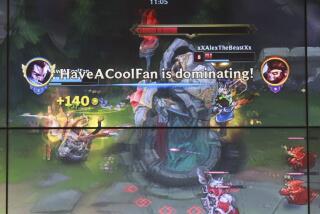SAG-AFTRA’s video game strike could spark unrest in other Hollywood labor unions

Members of SAG-AFTRA have officially called a strike against several video game companies.
- Share via
As an experienced voice actor in video games, Sunil Malhotra has exerted his vocal cords to the breaking point while performing blood-curdling screams and monster grunts for numerous titles including the popular “Diablo” and “X-Men” series.
“I’ve lost my voice for weeks at a time. I had to see a speech therapist to get my voice back,” the Los Angeles-based actor said. “If I don’t have my voice, I don’t function as an actor.”
Malhotra, 41, was one of more than 300 protesters who gathered Thursday at Warner Bros. in Burbank as part of the ongoing SAG-AFTRA strike against several major video game companies. Now in its third week with no resolution in sight, the work stoppage is threatening to drag out into a protracted fight that could have larger repercussions for Hollywood, which was last rocked by labor turmoil in 2007.
“I’m very resolved to stick with it as long as it takes,” Malhotra said. “At this point we have no other option.”
Members of SAG-AFTRA are protesting the way actors are paid and treated by the gaming industry. They are demanding better working conditions, including safeguards against vocal injury. They are also asking for backend residual-like payments, which are standard practice in film and TV, but not in gaming. Video game companies, which have offered an upfront wage increase, have balked at the demands as unrealistic.
The strike comes at a time of upheaval in Hollywood. Major producers and studios face enormous financial pressures as new technologies threaten old business models. TV networks are confronting rising competition from streaming sites like Netflix and traditional movie studios are having a tougher time attracting younger audiences to the multiplex. With industry change often comes labor unrest.
“There is now a fuzzy line between movies, TV, games, video,” said Daniel J.B. Mitchell, professor emeritus at UCLA’s Anderson Graduate School of Management and School of Public Affairs. “And there are issues of how to divide the pie, which can vary in size with the success of whatever is being made.”
The video game strike represents the first major act of defiance from the merged SAG-AFTRA, which was created by the joining of Hollywood’s two largest actors unions in 2012.
By combining forces, proponents of the merger argued that a single union would have greater leverage in negotiations and that producers would no longer be able to pit one union against the other.
With about 160,000 members who include singers and broadcasters, the combined union appears increasingly willing to flex its new clout.
Union leaders have stressed that issues behind the video game strike won’t necessarily apply to other contracts up for renewal, such as the main film and TV contract that expires June 30, 2017. Nonetheless, they have not been shy about sending a message to producers and studios.
“As a merged union we have a greater ability to take these kinds of actions than we did before,” said Ray Rodriguez, the chief contracts officer at SAG-AFTRA.
The union is currently fighting NBCUniversal over what it pays actors at the Spanish-language Telemundo compared to its English-language divisions. It is also sparring with Viacom’s BET channel over actors pay for the series “Being Mary Jane.”
“The strike is only hurting SAG-AFTRA’s own members and the union’s own standing in the videogame community and elsewhere,” said Scott Witlin, chief negotiator for the video game companies. “A prolonged, and likely failed strike, is not going to help anyone, particularly not the SAG-AFTRA.”
The video game strike so far has only affected a few thousand workers — the companies have the ability to hire non-union workers to meet their needs.
But SAG-AFTRA’s stand could embolden other unions such as the Writers Guild of America — whose 2007-08 strike shut down Hollywood — to take a harder stance in talks, thereby creating a cascading effect throughout the entertainment industry.
“It clearly gives other unions more leverage,” said Harley Shaiken, a labor economist and professor at UC Berkeley. “There’s a sense of solidarity and that increases the leverage of unions across the industry.”
The WGA declined to comment on the video game walkout. In a show of support, however, Writers Guild members protested with SAG-AFTRA at Warner Bros. on Thursday. Other unions present included IATSE, Actors’ Equity and the American Federation of Musicians.
The last major actors strike in Hollywood was in 2000, when performers fought over residual payments for TV and radio commercials. The strike lasted six months.
In 2008, SAG threatened to strike over contract negotiations with major studios. SAG accepted an agreement in 2009 that the union’s president vowed to oppose. The mishandled negotiations caused infighting within SAG, leading to the ouster of the union’s executive director and a widened rift with rival union AFTRA, which was able to negotiate separately with the producers. The turf battle ultimately led to the merger of the two unions.
The current video game strike, which began Oct. 21, is against several companies, including divisions of Warner Bros., Disney, Electronic Arts and Activision Blizzard.
“I know the guilds watch each other and take cues from each other, so this bears watching in the long term,” said David Smith, associate professor of economics at Pepperdine University Graziadio School of Business and Management.
Any hope of an amicable denouement in the dispute appears to be fading fast.
L.A.-based actor Oliver Vaquer said that he hopes the strike doesn’t last long because “it will do a disservice to everyone – a disservice to the fan, to the developers.”
But Vaquer, who has lent his voice to games including the “Skylanders” series, said the “money they’re paying us isn’t a living wage where it’s worth damaging my throat.… The system has to change.”
The current contract — known as the Interactive Media Agreement — expired in late 2014, but actors have continued to work under it as negotiations have dragged on for 19 months.
The big sticking point continues to be compensation, with the employers arguing that residual-like payments to actors is impossible because gaming is a fundamentally different industry than Hollywood.
Instead, the gaming companies have offered an upfront bonus payment based on the number of sessions a performer works on a particular title. They have also proposed a 9% wage increase, which would accelerate the 3% annual increase sought by SAG-AFTRA over a three-year period.
The hostility has increased in recent days, with the two sides sparring over a website that video game employers recently launched to promote their side of the debate. SAG-AFTRA contends that the site is masquerading as an official union communication and has demanded the companies stop using the SAG-AFTRA trademark on the site.
As the stalemate drags on, the union said that it is approaching gaming companies that are not involved in the dispute to adopt its proposal.
“We’re of course interested in signing with any employer,” said Rodriguez, the union’s negotiator. “We want to create as much work as we can for our members.”
Twitter: @DavidNgLAT
ALSO
The video game industry is booming — but voice actors feel left out of the success
As SAG-AFTRA strikes, video game companies hit back
Viacom quarterly profit plummets; Paramount loses $137 million
‘Doctor Strange’ to hold off ‘Arrival’ and ‘Almost Christmas’ at the box office
More to Read
Inside the business of entertainment
The Wide Shot brings you news, analysis and insights on everything from streaming wars to production — and what it all means for the future.
You may occasionally receive promotional content from the Los Angeles Times.











